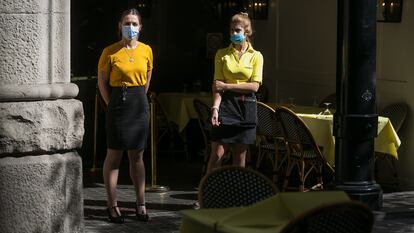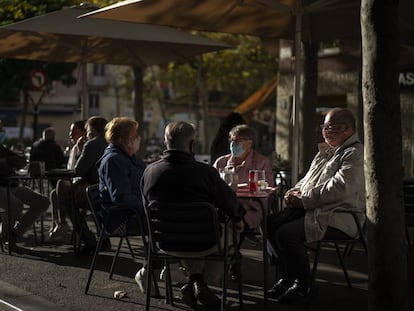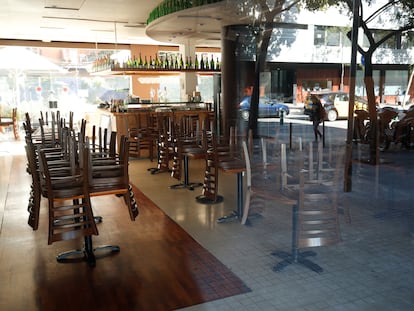What is behind the spike in coronavirus cases in Catalonia?
Experts blame the rising number of infections on the return to school, lifestyle changes and Barcelona’s relationship with contagion hotspots such as Madrid

The Catalan government had issued alerts about the coronavirus situation in the region, but just how serious it had become was not clear until last Sunday, when the regional health department shared this message on social media: “Warning for the elevated rise in Covid-19 cases in all of Catalonia. Exercise self-protection measures and reduce social contact.” It was a sign that foreshadowed new restrictions in the northeastern region.
Three days later, on Wednesday, the Catalan government announced the two-week closure of all bars and restaurants, a near-unprecedented move in Europe since the continent entered the second wave. This was also the first time one of Spain’s 17 regions had ordered such a drastic measure since the central government’s state of alarm came to an end in mid-June, and regional authorities were put in charge of containing the coronavirus crisis.
It is evident that the change happened two or three weeks after the reopening of schools and universitiesPere Godoy, president of the Spanish Epidemiology Society
“There was a significant increase in the incidence rate in the last 10 and 12 days. It is a general rise in almost all of Catalonia, but what is of particular concern now is that – unlike the last two months – the upward trend is stronger in Barcelona and its metropolitan areas,” says Clara Prats, a researcher in computational biology at the Polytechnic University of Catalonia.
Since August 2, the average seven-day cumulative number of coronavirus cases per 100,000 inhabitants in Catalonia had been fluctuating between 80 and 100 cases. It first started to rise in the week between September 27 and October 3, when it reached 114 cases, and the following week, it spiked to 159 (169 in the city of Barcelona), according to data from the regional government. The Spanish Health Ministry has defined these levels, which exceed the 250 cases per 100,000 inhabitants if the 14-day cumulative incidence is measured – as is also common – as a sign of a “high risk of uncontrolled transmission in the territory.”
Catalonia entered summer in almost the worst way possible – there were serious shortcomings in the contact-tracing system, part of Lleida province was confined due to a coronavirus outbreak and restrictions were introduced in L’Hospitalet de Llobregat, in Barcelona province, in a bid to curb contagion. The regional government was able to stabilize the impact of the virus but at an elevated level, with a hundred cases per 100,000 inhabitants and dozens of deaths a week. Despite this, there was still hope of a calm autumn.
“The most sensitive indicators now clearly show that the virus is spreading more in Catalonia,” says Daniel López Acuña, a former official at the World Health Organization (WHO). One of these indicators is the seven-day cumulative number of coronavirus cases per 100,000 inhabitants. Another is the positivity rate of PCR tests – i.e. the percentage of positive coronavirus diagnoses compared to the total carried out. This rate has risen from 5.7% to 8.4% in just two weeks. The reproduction number, or R-value – which measures how many people one infected person will pass on a virus to, on average – has gone from around one in summer to 1.4 (1.5 in Barcelona). “The data are clear. In a stable scenario, the spike happened in the first days of October. And it is widespread in all of Catalonia,” explains López Acuña.
The positivity rate of PCR tests in Catalonia has risen from 5.7% to 8.4% in just two weeks
Experts are now trying to work out what caused this sudden change. “It is evident that the change happened two or three weeks after the reopening of schools and universities,” says Pere Godoy, the president of the Spanish Epidemiology Society. “The return to class was necessary and many measures to prevent contagion have worked. But these figures show that things have to change, especially among older students. We have to review how students arrive and leave these centers, the use of common spaces and other activities with the highest risk of contagion,” he adds.
López Acuña agrees that “the environment of universities and secondary schools has the largest room for improvement.” “With the preventive measures in place, it is not so much that the school is the site of contagion. The problem is the context, the social dynamic that surrounds these centers,” he adds. Parties, nighttime venues and going out for drinks are the ideal breeding grounds for the virus, say experts. “These activities are not only practiced by these age groups, but they are the ones who do it the most. And that is what the regional government now wants to stop in a decision that I think is correct,” says López Acuña, in reference to the move to close bars and restaurants for 15 days. The arrival of people from areas with a high incidence of the virus, such as Madrid, is another factor, he says.
The research team of Clara Prats writes weekly reports analyzing the evolution of the pandemic for the European Commission. “For months, the 20-29 age group has had a high incidence rate, double the average in Catalonia. It is also above the 30-50 age group, while the youngest and oldest age groups have remained below the average,” she says.
Lifestyle changes
Although the figures did not detect a rise in cases before October, some experts believe the spike is due to changes that happened at the beginning of September. “We went from a life spent outdoors, typical of summer, to another one more focused on closed spaces with the return to work,” says Magda Campins, the head of preventive medicine at Vall d’Hebron hospital. “This, combined with a certain relaxation of the safety measures by some of the population, explains what is happening.”
Prats agrees: “I think it is linked to the change from the lifestyle in August to the one in September and October, a working and studying life in more closed areas, with everything that this entails.”
The epidemiologist Pedro Alonso argues that in Spain, unlike other countries such as Italy, people “have relaxed their activity in bars and restaurants.” “This, combined with the great connectivity between, for example, Barcelona and Madrid or Paris [which have high incidences of the coronavirus], as well as the return to school, are factors that have contributed [to the rise in coronavirus cases],” says Alonso, who leads the WHO’s program against malaria. But Alonso agrees with the rest of the experts that “it is definitely too soon to reach conclusions” about the spike in infections, explaining that “now is the time to analyze all possible causes.” This analysis would have to look at why the return to school appears to have had a bigger impact in Catalonia than in other Spanish regions.
Hospitals in Catalonia have already begun to notice the increased pressure due to the coronavirus outbreak in the region. “We have noticed a significant spike in cases that have been admitted to hospital and intensive care units. Tomorrow [this Thursday] we will open a third floor for Covid-19 patients,” says Campins, from the Vall d’Hebron hospital, which is the largest in Catalonia. “For now, the increased pressure has been less than the incidence rate, given that most diagnoses are in young and healthy people. But this is also beginning to change. The average age of our patients has gone from 45 years old to between 60 and 65,” she explains.
This pressure is a common problem in the public healthcare network in Catalonia, reports Jessica Mouzo. Hospitals have been on alert for days and are watching the evolution of coronavirus admissions closely. While hospitals have not currently had to suspend scheduled operations, they have contingency plans in place in case the situation worsens.
English version by Melissa Kitson.
Tu suscripción se está usando en otro dispositivo
¿Quieres añadir otro usuario a tu suscripción?
Si continúas leyendo en este dispositivo, no se podrá leer en el otro.
FlechaTu suscripción se está usando en otro dispositivo y solo puedes acceder a EL PAÍS desde un dispositivo a la vez.
Si quieres compartir tu cuenta, cambia tu suscripción a la modalidad Premium, así podrás añadir otro usuario. Cada uno accederá con su propia cuenta de email, lo que os permitirá personalizar vuestra experiencia en EL PAÍS.
¿Tienes una suscripción de empresa? Accede aquí para contratar más cuentas.
En el caso de no saber quién está usando tu cuenta, te recomendamos cambiar tu contraseña aquí.
Si decides continuar compartiendo tu cuenta, este mensaje se mostrará en tu dispositivo y en el de la otra persona que está usando tu cuenta de forma indefinida, afectando a tu experiencia de lectura. Puedes consultar aquí los términos y condiciones de la suscripción digital.
More information
Últimas noticias
Most viewed
- Sinaloa Cartel war is taking its toll on Los Chapitos
- Reinhard Genzel, Nobel laureate in physics: ‘One-minute videos will never give you the truth’
- Oona Chaplin: ‘I told James Cameron that I was living in a treehouse and starting a permaculture project with a friend’
- Why the price of coffee has skyrocketed: from Brazilian plantations to specialty coffee houses
- David King, chemist: ‘There are scientists studying how to cool the planet; nobody should stop these experiments from happening’











































